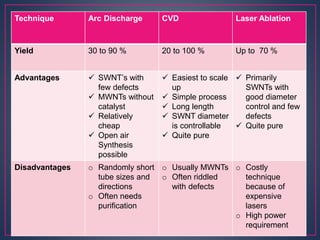Carbon nanotubes
- 1. HACETTEPE UNIVERSITY MATERIAL SCIENCE AND ENGINEERING
- 3. âĒ Carbon Nanotubes, long, thin cylinders of carbon, were discovered in 1991 by Sumio Lijima. âĒ Unique size, shape, and remarkable physical properties. âĒ Very broad range of electronic, thermal, and structural properties that change depending on the different kinds of nanotube.
- 5. Most single-walled nanotubes (SWNT) have a diameter of close to 1 nanometre, with a tube length that can be many millions of times longer.
- 7. âĒ ZIGZAG âĒ ARMCHAIR âĒ CHIRAL
- 8. Multi-walled nanotubes (MWNT) consist of multiple rolled layers (concentric tubes) of graphite.
- 9. âĒ A carbon nanotube contains another nanotube inside it (the inner nanotube has a smaller diameter than the outer nanotube) Parchment Model âĒ A single graphene sheet is rolled around itself multiple times, resembling a rolled up scroll of paper
- 11. Technique Arc Discharge CVD Laser Ablation Yield 30 to 90 % 20 to 100 % Up to 70 % Advantages ïž SWNTâs with few defects ïž MWNTs without catalyst ïž Relatively cheap ïž Open air Synthesis possible ïž Easiest to scale up ïž Simple process ïž Long length ïž SWNT diameter is controllable ïž Quite pure ïž Primarily SWNTs with good diameter control and few defects ïž Quite pure Disadvantages o Randomly short tube sizes and directions o Often needs purification o Usually MWNTs o Often riddled with defects o Costly technique because of expensive lasers o High power requirement
- 12. âĒ Low Density âĒ High Tensile Strength âĒ High Resillence âĒ High Current Carrying Capacity âĒ High Heat Transmission âĒ High Temperature Stability âĒ High Cost [Sorting, Purification]
- 13. Small and lightweight Resistant to temperature changes Improvement for plastics and composites Clean, bulk micromachining and assembly of components
- 14. Working principles are mystery Difficult to work with Expensive to produce Enviromental concerns












![âĒ Low Density
âĒ High Tensile Strength
âĒ High Resillence
âĒ High Current Carrying Capacity
âĒ High Heat Transmission
âĒ High Temperature Stability
âĒ High Cost [Sorting, Purification]](https://image.slidesharecdn.com/glnur-carbonnantubessunum-141204082845-conversion-gate01/85/Carbon-nanotubes-12-320.jpg)




